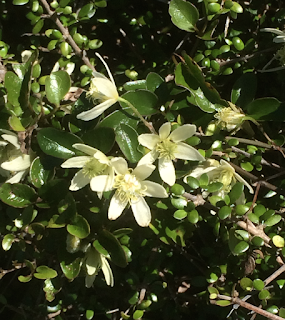Volunteer work takes me for a walk along the coast several mornings a month in summer. Walking the same path, day after day, isn't dull or a chore.
 |
| The path along the coast, white-faced heron ahead |
Each day, I see something different, depending perhaps on the weather or the tide, or I see something differently. Sometimes there are big changes: a storm leaves soft-bodied jelly fish and bright orange sponges stranded on the beach and covers the path with driftwood.
 |
| After the storm - jellyfish on the beach |
But there may be no change at all, just that I am suddenly aware of an unusual plant that I've walked past before, unseeing.
 |
| Shore bindweed - NZ native |
I'm intrigued by the act of naming and describing. How, what was before a mass of greenery or stalks, becomes individual plants of different shades of green, textured with spikes, tendrils or berries. Before the naming, we might say to ourselves "there's that plant with those waxy berries again" or "the vine with the pink flowers". But after the naming, we walk along and say out loud, "that's Muehlenbeckia complexa" or "ahh Shore Bindweed, did you know it's native?"
 |
| Muehlenbeckia complexa, scrambling pohuehue |
And then we can't walk along without noticing, the plants never return to a mass of indistinguishable greenery, our perception is changed forever.
This summer, the weeds are to blame for my changing perception. Weed control - spraying - takes place a few times a year. I wanted to know which were the weeds, those pesky smotherers, and which were the native plants to be encouraged.
I decided to use
iNaturalistNZ to photograph and record plants as I noticed them. With the help of botanists around New Zealand I was able to identify what I was seeing - finding a name to distinguish one from another.
 |
| Some of my Nature Watch entries |
There are only a few of these native plants along the pathway:
 |
| Coastal cutty grass |
 |
| Knobby clubrush |
 |
| Arnim's comments on iNaturalistNZ about Knobby clubrush |
 |
| New Zealand flax |
Common bushes include: Muehlenbeckia complexa or scrambling pohuehue (see above photo), Ozothamnus leptophyllus or tauhinu, and Coprosma propinqua or miki
 |
| Tauhinu |
 |
Miki (with a copper butterfly)
|
There are a few trees, karaka, taupata, kawakawa, kaikomako, mahoe. I won't show them all here, just kaikomako, as that's perhaps the least well known of them.
 |
| kaikomako |
And some interesting vine-like plants: New Zealand spinach, clematis, shore bindweed (photo above).














No comments:
Post a Comment